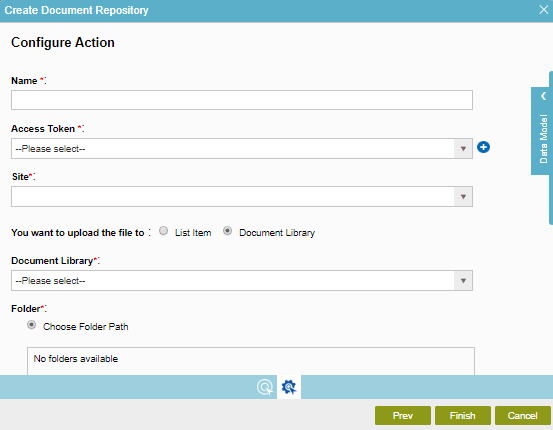Repository Details for SharePoint
Specifies the location of your files in SharePoint for the File Upload form control.

Examples
Good to Know
- Some information about third-party integrations is outside the scope of the AgilePoint NX Product Documentation, and it is the responsibility of the vendors who create and maintain these technologies to provide this information. This includes specific business uses cases and examples; explanations for third-party concepts; details about the data models and input and output data formats for third-party technologies; and various types of IDs, URL patterns, connection string formats, and other technical information that is specific to the third-party technologies. For more information, refer to Where Can I Find Information and Examples for Third-Party Integrations?
How to Start
- On the Application Explorer screen, do one of these:
- Configure a document repository for an eForm:
- Do one of these:
- Do one of these:
- Add a File Upload
 control:
control:
- On the eForm Builder screen, in the Toolbox, open the Common Controls
 tab.
tab. - On the Common Controls
 tab, drag a File Upload
tab, drag a File Upload  form control onto your eForm.
form control onto your eForm.
- On the eForm Builder screen, in the Toolbox, open the Common Controls
- Change a File Upload
 control:
control: - On your eForm, click the control, and click Edit
 .
.
- On your eForm, click the control, and click Edit
- Add a File Upload
- On the Configure tab, click Add Repository
 .
.
- Configure a document repository for an application:
- On the right pane, click Quick Links.
- On the Quick Links screen, click Add Document Repository.
- Configure a document repository for an eForm:
- On the Choose Document Repository screen screen, select SharePoint
 , and click Next.
, and click Next.
Fields
| Field Name | Definition |
|---|---|
Name |
|
Access Token |
|
Add New |
|
Site |
|
You want to upload the file to |
|
Document Library |
|
Folder |
|
New Folder |
|
|
Lists |
|
|
List Item ID |
|
File Action |
|


